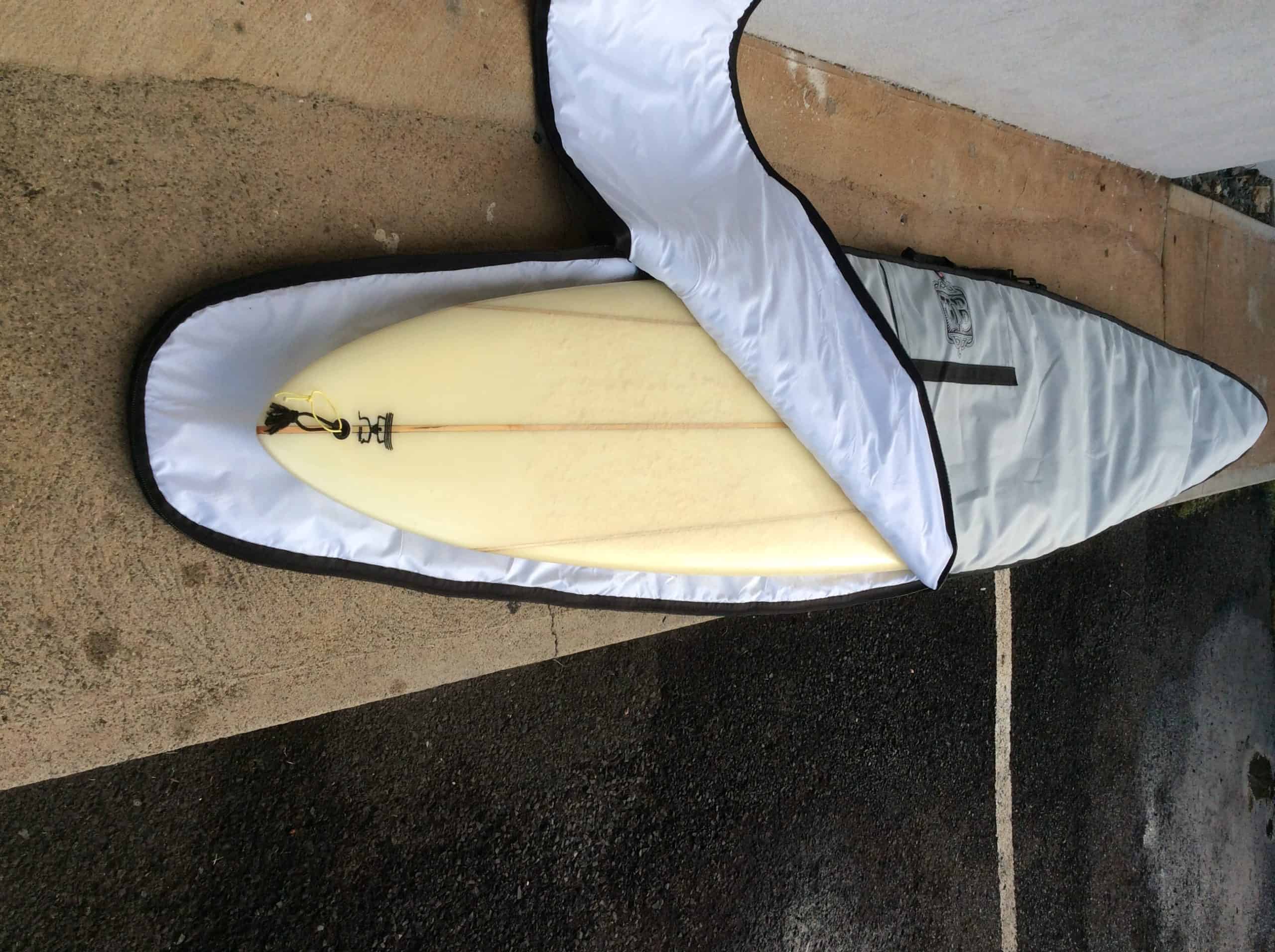What’s the first thing you want to do after surfing? Probably eat a burrito, take a nap, or something of the sort.
The last thing you probably want to do is chores. But there are a few associated with taking care of your gear, especially your board. Taking care of your board is a big deal when it comes to maintenance of your gear.
Some seem like good suggestions, but are they really that important? Like do you really need to wash your board after every surf session? You don’t need to soap up your board, but yes, you should give it a fresh water rinse after every surf.
While there are plenty of people that do not wash off their board after surfing, suggested best practice is to do so.
Salt water is a corrosive substance. When you leave your board full of salt, it eats away at the resin, damaging your board.
It’s a slow process though, so if you don’t rinse your board off once, you likely won’t immediately see damage or deterioration. But don’t let that fool you into thinking it’s an unnecessary step.
Over time salt water damage will accumulate, deteriorating the materials your board is made of. So while some people may say it’s not a big deal, you should definitely give your board a good rinse after every surf for best practice.
After all, It’s easy to do and won’t take up much of your time. Most beaches and surf breaks have showers nearby the bathrooms or entrances to the beach to clean off sand.
You can use these to give your board a fresh water rinse before heading to the car. If there aren’t showers at your break, no big deal, just use the hose to clean off when you get home.
Leaving the salt on your board for the duration of the car ride home won’t make it or break it in terms of damage to your board. Just make sure you’ve cleaned off all the salt water as soon as you can after surfing.
Your board is your biggest investment when it comes to surfing, afterall, you can’t surf without one. So it’s important to give it the best care possible so that it can last you as long as possible.
Rinsing off the salt water is just one of several key points for maintaining your board.
Again, surfboards are an investment into surfing and it’s important to keep it in tip top shape so you can count on the best performance possible out on the waves.
How Sun and Heat Can Destroy Your Surfboard
It may sound counterintuitive since you’re bringing your board to the beach where sun and heat are unavoidable, however, prolonged UV exposure is bad for your board.
Not only will sun exposure change the color, taking it from bright white to dingy yellow, but more importantly the sun will cause damage to the materials your board is made of.
It will deteriorate the foam of the board causing delamination, or separation of the fiberglass and the foam.
In addition to UV rays, heat itself is terrible for your board, causing it to warp and even melt. So when you aren’t actively surfing, keep it out of the sun and away from heat.
When you’re at the beach taking a break from the waves, cover your board with towels or better yet, stick it under an umbrella while your board isn’t in use. When you’re not out surfing, keep it stored out of direct sunlight, somewhere it stays cool.
On that note, never store your board in the car. A parked car gets incredibly hot inside and heat is the enemy of your surfboard. Leaving it in a hot car will definitely lead to significant damage.
It’s better to drop it off at home before going to do anything else. If you do have to leave your board in the car for some reason, park it in the shade and leave the windows cracked. It will help keep your board from getting too hot.
Outside of absolutely necessary situations though, keep your board away from heat and in the shade or indoors.

Get a Board Bag
Keep your surfboard in a board bag. Think of it like a case for your smartphone, protecting it from damage.
Using a board bag will provide easier transportation and help keep your board from getting dinged up along the way. They even offer UV protection.
Having your board stored in a bag will provide it with an extra layer of protection. This will keep it from possible harm when sitting in the bed of your truck or strapped to the roof of your car when headed to the beach.

It also makes it easier to carry down to the water. Most board bags come with a strap so you don’t have to worry about getting your arm around your board or dropping it on the hike to shore.
Repair Dings
A huge aspect in taking care of your board is to watch out for dings in it. There’s two types, pressure dings and puncture dings.
Basically one is a flesh wound and one is a deep wound. Pressure dings come from, yes, pressure applied to the board that fractures the fiberglass. Puncture dings are from objects that hit your board with strong force and actually pierce it.
Both require repair as soon as possible. When you leave dings and other cuts in your board, water seeps in destroying the foam it’s made from.
Waterlogging also causes the board to get heavier, affecting its ability to float and therefore its performance when surfing. After every surf, check your board for damage it may have incurred while you were out on the water.
If you find any dings, take it to a repair shop. For minor repairs, you can always DIY. Surf shops sell repair kits that come with everything you need.
Keep ding tape in your bag for minor emergency situations while you’re out for a session. Never use wax or duct tape to try and fix damage to your board.
They can’t create watertight seals, so salt water will make its way in anyway. Wax is unable to stick that tightly, while the strings of duct tape are actually water absorbent.
Ding tape on the other hand, is made with a marine glue that will help tide you over until you get home to fix your board.
Remove Your Wax
Another big part of board care is the removal and application of wax. It’s important to remove your wax every month or so to be able to check your board for repairs it might need.
You may be checking after you surf, but small damage can be easily covered up by wax buildup on your deck. Regularly clearing everything off for a thorough inspection will keep little issues from turning into major work.
It’s also just good practice to routinely give your board a fresh wax job. Wax builds up and gets dirty over time.
The sand, dirt and excessive buildup cause the wax to lose traction. Fully cleaning it off every so often will help keep your wax fresh and sticky.
When removing wax, stay away from strong chemicals and metal tools. Only use materials approved for surfboards.
The wrong solvents will quickly eat away at the epoxy and resin your board is made of while metal will scratch and damage it. Stick with plastic scrapers, like the one on the backside of your wax comb.
When cleaning off wax residue after scraping, use a specific surfboard cleaner, or try coconut oil, a popular tool of surfers when it comes to cleaning their boards.
How To Store Your Surfboard Properly
When you’re not out surfing, make sure your board is properly stored away. Keep it out of direct sunlight and heat, somewhere cool and shaded. You also want to make sure your board won’t get banged up wherever you keep it.
The best option is to hang it up flat on a rack. You can get wooden dowels for cheap at the store to drill into the wall, or purchase a specific board rack as well.
Storing your board on the ground can damage your fins and tail from the pressure. Setting them on a rack relieves that weight, although it’s still a good idea to pad the rack with a towel or thin foam to relieve any pressure points.
Never stack boards on top of each other. Doing so can crack your board or break your fins off thanks to the extra weight and will definitely scratch up the boards on the bottom.
Not to mention, stacking boards on each other or leaning them against one another will get wax all over the underside of them. Wax under your board messes with water flow and can lower your performance in the waves.
If your board has to be stored upright, stick some padding underneath it to prevent damage to the tail. And again, always store it inside or somewhere cool and shady.
Related Questions
How Long Do Surfboards Last?
Boards are the most crucial piece of gear when it comes to surfing. Some boards last a season, while other people will use a board for ten years.
The general answer is somewhere in between. With good care, a surfboard should last several years.
Should You Wax a Foam Board?
It may seem funny, but you should still wax a foam board. Wax gives a board grip, which is essential in order to grab hold and stay standing while out on the water.
Some foam boards are made with some grip, but waxing will ensure you have traction.You won’t need your board heavily covered, but a nice thin layer will help your performance in the waves.

